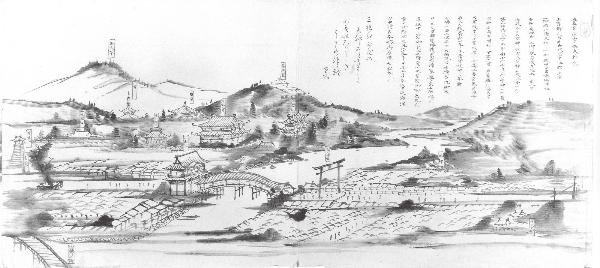Usa Jingu Shrine

Usa Jingu Shrine on an illustrated map
(early fifteenth century)
Usa Jingu is one of the most important Shinto shrines in Japan with a history that spans close to 1,300 years. Its main deity is Hachiman, who is worshipped as a guardian of the country and the imperial family. Shrines dedicated to Hachiman are among the most numerous in Japan, counting tens of thousands, and Usa Jingu serves as their head shrine. In addition, Usa Jingu is one of only 17 shrines entitled to receive chokushi (imperial messengers), reflecting its historic relationship to the imperial court.


Usa Jingu depicted in The Illustrated Diary of Minomushi Sanjin (1864)
Usa Jingu was one of the earliest sites where a syncretic form of Shinto and Buddhist worship called shinbutsu shugo developed, shaping Usa Jingu into a large and influential shrine-temple complex. After the separation of Shinto and Buddhism in the late nineteenth century it became a purely Shinto shrine, but some of the present-day practices still reflect its syncretic past. Researchers believe that several other traditions also originated at Usa Jingu, including the use of mikoshi portable shrines to transport deities from one place to another, hojo-e rituals in which captured animals are released to absolve wrongdoings, and the distinctive twin-roof hachiman-zukuri architecture style.

Mikoshi portable shrines

Hachiman-zukuri architecture

Hojo-e ritual
Shrine Grounds
The vast Usa Jingu complex is located on and around Mt. Ogura. Its focal points are the Jogu (Upper Shrine) on top of the mountain and the Gegu (Lower Shrine) at its base. A number of subsidiary and auxiliary shrines are scattered about the grounds and on neighboring hills, and the innermost shrine (okunomiya) is located on Mt. Omoto some 6 kilometers south.

Aerial view of the shrine grounds

Treasure Hall
Much of the Usa Jingu grounds are covered by forest that provides a beautiful backdrop for the bright vermilion sanctuaries, torii gates, and bridges. Several ponds and the surrounding area feature abundant seasonal flowers and serve as a habitat for a variety of wildlife. The Treasure Hall next to one of the ponds holds exhibitions that display mikoshi, oracle records, statues, swords, ritual tools, and various historical documents. Usa Jingu has several National Treasures and numerous Important Cultural Properties.
History and Enshrined Deities

Hishigata Pond and Mt. Ogura
Usa Jingu enshrines three main deities. The most prominent of them is Hachiman, the deified spirit of Emperor Ojin (the 15th emperor of Japan). He is worshipped alongside his mother, Empress Jingu, and the Hime Okami, a collective name for a trio of sea goddesses revered in Usa since ancient times. According to shrine records, Hachiman first appeared near Mt. Ogura in 571 and declared himself a protector of Japan. The location where Hachiman was enshrined changed several times until a suitably large site was chosen atop Mt. Ogura and a sanctuary was built there in 725.
Many emperors, nobles, warrior clan leaders, and other powerful figures throughout history prayed to Hachiman. In the eighth century, the emperor invited the deity to make a pilgrimage to Todaiji Temple in Nara (then the capital of Japan) during construction of the Great Buddha statue. Several decades later, Hachiman’s oracles at Usa Jingu were consulted regarding matters of imperial succession. In the tenth century, the imperial court appealed to Hachiman to help subdue a rebellion against the central government. When Mongols attempted to invade Japan in the thirteenth century, the people turned to Hachiman for protection, and it was believed that he caused the storms that thwarted the Mongol attacks.

Usa Mikoshi Festival recreating Hachiman’s visit to Todaiji Temple in Nara (2017)

Shrine grounds during the Great Showa Reconstruction (1932–1941)
Since Hachiman was viewed as a protector deity, his importance to the ruling class enabled the spread of Hachiman worship across the country. Usa Jingu held considerable power and influence as the head Hachiman shrine, at one point becoming the largest landowner in Kyushu. However, its position weakened with changes in the political landscape and the rise of the samurai class, and the shrine gradually lost most of its land holdings. After imperial rule was restored in 1868, a government decree assigned high ranks to a number of Shinto shrines including Usa Jingu, which facilitated its revival. During the Great Showa Reconstruction (1932–1941), the entire grounds of the shrine were renovated and Usa Jingu assumed its present layout and appearance.

Main sanctuary area at the Jogu (Upper Shrine)
Shinbutsu Shugo Syncretic Worship
Usa Jingu is considered to have been one of the starting points of Shinto and Buddhist syncretic worship, which began to take shape in the eighth century after the introduction of Buddhism to Japan. Usa Jingu soon evolved into a large shrine-temple complex where religious rites were conducted by both Shinto priests and Buddhist monks. The main Buddhist temple on the grounds was Mirokuji Temple, which performed religious and administrative functions. As Shinto-Buddhist syncretism spread across the country together with Hachiman worship, Usa Jingu became a model for other shrine-temple complexes. The syncretic form of worship was practiced for many centuries until the Meiji government ordered the separation of Shinto and Buddhism in 1868. After that, all Buddhist structures were removed from Usa Jingu and it became a purely Shinto institution. Nevertheless, certain rituals and festivals held at Usa Jingu throughout the year still reflect the shrine’s syncretic roots.

Rokugo Manzan Pilgrimage

Hokke Hakko ritual

Chushusai festival

This English-language text was created by Japan Tourism Agency.
- ページに関する評価
-







更新日:2024年03月18日